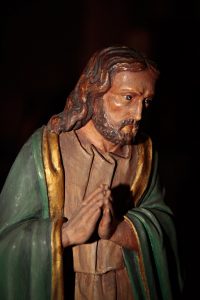In earlier posts, we have highlighted women whose names and some of their roles in the Jesus movement we know, many of whom have long been ignored in the history of New (Christian) Testament scholarship (and Sunday School stories): women from Paul’s letter to the Romans, Chapter 16 (the apostle Junia, the deacon Phoebe, the missionary pair of Tryphaena and Tryphosa, Prisca/Priscilla, Mary, and Julia), as well as Persis; the missionary pair Evodia and Syntyche in Philippians; Chloe in I Corinthians; and Nympha in the letter to the Colossians.  We have seen that these women were not only respected by St. Paul and other men in the movement but also leaders in the same way that men were and possibly founders of significant communities in places like Rome. While many Christians and Christian groups today still hold to the position that women should not hold leadership roles, and those Christians frequently base their stance on Christian Testament passages, the reality no longer bears that out.
We have seen that these women were not only respected by St. Paul and other men in the movement but also leaders in the same way that men were and possibly founders of significant communities in places like Rome. While many Christians and Christian groups today still hold to the position that women should not hold leadership roles, and those Christians frequently base their stance on Christian Testament passages, the reality no longer bears that out.
Here, in celebration of Women’s History Month, we will take this discussion one step further by highlighting the “invisible” women – those who were undoubtedly important to the mission but unnamed. We will rely on the women scholars who contributed to the groundbreaking volume, Meyers et al, Women in Scripture: A Dictionary of Named and Unnamed Women in the Hebrew Bible, the Apocryphal/Deuterocanonical Books, and the New Testament. Women in Scripture devotes nearly 100 pages (408-503) to unnamed women in the Christian Testament alone.
 Throughout history, women – and many men – have lived their lives and contributed to their communities completely “under the radar.” In this post, we offer a very modest corrective to that tragic (but all-too-common) “silent treatment” by focusing on a selection of anonymous female figures from the Christian Testament. These short biosketches will add to our knowledge of the ancient world and show how recent (mostly female) scholars are casting new light on passages that have traditionally been analyzed from a male perspective.
Throughout history, women – and many men – have lived their lives and contributed to their communities completely “under the radar.” In this post, we offer a very modest corrective to that tragic (but all-too-common) “silent treatment” by focusing on a selection of anonymous female figures from the Christian Testament. These short biosketches will add to our knowledge of the ancient world and show how recent (mostly female) scholars are casting new light on passages that have traditionally been analyzed from a male perspective.
Unnamed women in St. Paul’s circle
We examined two unnamed women from Romans 16 earlier: the mother of Rufus and the sister of Nereus. Scholar Jouette Bassler has written on both of these women. Rufus’ mother appears to have had a special relationship with Paul: his reference to her as his (figurative) “mother” probably means that she showed “generous hospitality” to Paul or perhaps served as his patron (Women in Scripture, 469). Nereus’ sister, judging by the use of the term in antiquity, could have been Nereus’ wife, but in this context, she and Nereus were likely biological siblings and could also have been children of the couple Julia and Philologus (Rom 16:15) (Women in Scripture, 470).
Continuing with Pauline circles, in I Cor 9:5, St. Paul uses a Greek phrase with two words together: adelphe and gyne. Adelphe is usually translated “sister,” while gyne can be translated “women” or “wife.” Mitchell (Women in Scripture, 474-75) argues that Paul’s phrasing here is strange because the words are redundant in context. ![]() The more traditional interpretation of this combination over the centuries is to wives of the male movement members “to provide for their domestic needs while the men accomplished the important work of evangelization.” More recently, however, feminist scholars suggest that these male-female couples may have been missionary pairs (a topic we have considered elsewhere). The bottom line is that “women were active in missionary activity alongside their now better-known husbands,” and we are grateful to scholars such as Mitchell for stressing this probability.
The more traditional interpretation of this combination over the centuries is to wives of the male movement members “to provide for their domestic needs while the men accomplished the important work of evangelization.” More recently, however, feminist scholars suggest that these male-female couples may have been missionary pairs (a topic we have considered elsewhere). The bottom line is that “women were active in missionary activity alongside their now better-known husbands,” and we are grateful to scholars such as Mitchell for stressing this probability.
Two passages in the first letter of Paul to the Corinthians are especially problematic with regard to women in the early congregations. In I Cor 11:2-16, Paul tells women that they should wear a veil while praying in church. As scholar Mitchell points out (Women in Scripture, 475-77), this is “one of the most tortured [passages] in Paul’s letters.” Paul seems to be trying to constrain women’s prophetic freedom to some extent. But his approach throughout the argument vacillates, which may actually show “part of his overall strategy of mediation” with a divided congregation. At base, though, we can legitimately posit that women were paramount in the liturgical and prophetic life of the Corinthian community.
 A few chapters later, a similar conundrum is found: I Cor 14: 33b-36 also seems to fly in the face of evidence in Paul’s authentic letters that shows his high esteem for women he knows. In these verses in Chapter 14, women are commanded to be silent in the Jesus groups, to ask their husbands for information at home, and to be subordinate. There are many scholarly theories about this passage and no one definitive explanation for its inclusion, especially given Paul’s obvious respect for three named women associated with Corinth: Phoebe, a deacon in the nearby congregation at Cenchreae (Rom 16:1); Chloe (I Cor 1:11); and the renowned Prisca/Priscilla (I Cor. 16:19 and Rom 16:3, as well as II Tim. 4:19 and Acts 18). One theory about this passage’s inclusion is that it is another example of Paul’s negotiations with this congregation (Mitchell, Women in Scripture, 477-78); we may never know the full story about this difficult passage, but its negative perspective toward women must be balanced by the more positive examples of women in the Pauline corpus and not taken at face value.
A few chapters later, a similar conundrum is found: I Cor 14: 33b-36 also seems to fly in the face of evidence in Paul’s authentic letters that shows his high esteem for women he knows. In these verses in Chapter 14, women are commanded to be silent in the Jesus groups, to ask their husbands for information at home, and to be subordinate. There are many scholarly theories about this passage and no one definitive explanation for its inclusion, especially given Paul’s obvious respect for three named women associated with Corinth: Phoebe, a deacon in the nearby congregation at Cenchreae (Rom 16:1); Chloe (I Cor 1:11); and the renowned Prisca/Priscilla (I Cor. 16:19 and Rom 16:3, as well as II Tim. 4:19 and Acts 18). One theory about this passage’s inclusion is that it is another example of Paul’s negotiations with this congregation (Mitchell, Women in Scripture, 477-78); we may never know the full story about this difficult passage, but its negative perspective toward women must be balanced by the more positive examples of women in the Pauline corpus and not taken at face value.
Unnamed women in non-Pauline letters
The epistles designated “Pastoral” – I and II Timothy and Titus – have traditionally been attributed to Paul but were most likely written well after his death, around 100-150 CE. This is significant because of these letters’ treatment of women, as we have discussed earlier. Here, we note specifically I Tim 2:9-15, where women are exhorted to dress modestly and to “learn in silence with full submission,” and where they may not teach and must have no authority over men. As Brown points out (Women in Scripture, 487-89), citing scholar Joanna Dewey, “the author [of I Timothy] would not have spent so much time and effort instructing Christian women to remain silent unless the goal was to change already existing behavior.” Thus this negative passage is yet another in the texts handed down to us that we cannot take at face value: there are real women in the early communities exhibiting agency, action and leadership – to the dismay (?) of many men.
Similarly, the author of the Pastoral Letter Titus also expressed concern for correct behavior (Tanzer, Women in Scripture, 494-95). Titus 2:3-5 exhorts older and younger women in circumscribed ways. (Notably, older men, younger men and slaves are also exhorted about their behavior, but the author spends more time on his commands to women.) At this time in the history of the Jesus movement, the growing male hierarchy was trying to conform “to social norms and submission to appropriate authorities,” so women’s behavior, in their opinion, needed to be circumscribed.
Two women are mentioned in the small letter II John: Elect Lady and Elect Sister. II John was written around 90-120 CE.
- II John 1, 5 mentions an “elect lady.” We do not know if Elect Lady refers to an actual woman: the Greek term could be metaphorical. However, the mention of her house in verse 10 suggests that this is a real woman who was able to host small Jesus groups (Kraemer, Women in Scripture, 500-01).
- II John 13 refers to “your elect sister.” Like “elect lady,” this is quite intriguing – is she real or metaphorical (Kraemer, Women in Scripture, 501)? At the very least, II John’s author is respectfully addressing women in this congregation.
Unnamed women in Jesus’ circle
 There are a number of unnamed women mentioned in the canonical gospels who are associated with Jesus; we deal with these last because the gospel accounts were not only written later, generally speaking, than the Pauline and non-Pauline letters but are also perhaps more likely to be fictional than historical. However, these examples – as analyzed by female scholars over the past few decades – serve to support our argument that women were active players in the early Jesus movement and highly regarded.
There are a number of unnamed women mentioned in the canonical gospels who are associated with Jesus; we deal with these last because the gospel accounts were not only written later, generally speaking, than the Pauline and non-Pauline letters but are also perhaps more likely to be fictional than historical. However, these examples – as analyzed by female scholars over the past few decades – serve to support our argument that women were active players in the early Jesus movement and highly regarded.
The Synoptic Gospels – Matthew, Mark and Luke – record many of the same stories about Jesus and his followers, but their perspectives and theological motives usually differ. Therefore, we will highlight an unnamed woman who appears in the Synoptics: the woman who anointed Jesus with expensive oil.
The story appears in Matt 26:6-13, Mark 14:3-9, and Luke 7:36-50. (In John 12:1-8, the woman is not anonymous but is identified with Mary, the sister of Martha and Lazarus; Kraemer, Women in Scripture, 455). Scholar Mary Rose D’Angelo posits that, since Mark is the earliest canonical gospel and this story in Matthew follows Mark’s version very closely, a primary purpose of Matthew is to present this woman “as an example of true discipleship and service.” In Mark, significantly, according to D’Angelo (and following other scholars), the promise embedded in the story – that “wherever the good news is proclaimed in the whole world, what she has done will be told in remembrance of her” (NRSV) – shows the possibility that Mark is using the voice of the woman herself to tell the story. While it is unlikely that the gospel itself was written by a woman, the use of a woman’s perspective could have served to draw a female audience into the story and raise their status as prophets and companions of Jesus. This indeed would be good news for women in the movement (D’Angelo, Women in Scripture, 436)!
In Luke’s telling, the focus turns to the meal setting, Simon Peter’s behavior, the woman’s designation as a sinner, and Jesus’ magnanimity in forgiving the woman’s supposed sins. For Luke, the emphasis is on Jesus more than the woman. While she is not completely invisible, her role is diminished in Luke compared to how it is portrayed in Mark or Matthew.
Summary
As we can see, the Christian Testament texts reflect a range of attitudes toward women and their roles in the early Jesus groups. Thanks to the efforts of many female scholars over the past 30-40 years, we know considerably more about women in the early movement than readers of the Bible did in past generations. One thing that is certain: our female ancestors in the faith – and thus ancestors of Western civilization – served as financial supporters of the mission, loyal followers of Jesus, independent actors, traveling missionaries, community founders and leaders of both women and men. May we honor and take inspiration from them not only during Women’s History Month but always!
Resources
Bassler, Jouette M. “Mother of Rufus,” in Women in Scripture, 469.
Bassler, Jouette M., “Sister of Nereus,” in Women in Scripture, 470.
Brown, Lucinda A. “Women Who Profess Reverence for God,” in Meyers et al, Women in Scripture, 487-89.
D’Angelo, Mary Rose. “Woman Who Anoints Jesus” (Matt 26:6-13), in Meyers et al, Women in Scripture, 419.
D’Angelo, Mary Rose. “Woman Who Anoints Jesus” (Mark 14:3-9), in Meyers et al, Women in Scripture, 434-36.
D’Angelo, Mary Rose. “Woman Who Anoints Jesus” (Luke 7:36-50), in Meyers et al, Women in Scripture, 440-41.
Kraemer, Ross S. “Elect Lady,” in Meyers et al, Women in Scripture, 500-01.
Kraemer, Ross S. “Elect Sister,” in Meyers et al, Women in Scripture, 501.
Kraemer, Ross S. “Woman Who Anoints Jesus” (John 12:1-8), in Meyers et al, Women in Scripture, 455.
Meyers, Carol, Toni Craven and Ross S. Kraemer, eds., Women in Scripture: A Dictionary of Named and Unnamed Women in the Hebrew Bible, the Apocryphal/Deuterocanonical Books, and the New Testament. Grand Rapids, MI, and Cambridge, England: William B. Eerdmans Publishing Company, 2000.
Mitchell, Margaret M. “Sister/Wife Who Accompanies Apostles Other Than Paul,” in Meyers et al, Women in Scripture, 474-75.
Mitchell, Margaret M. “Women Commanded to Be ‘Silent’ in the Assemblies,” in Meyers et al, Women in Scripture, 477-78.
Mitchell, Margaret M. “Women Praying and Prophesying,” in Meyers et al, Women in Scripture, 475-77.
Tanzer, Sarah J. “Older and Younger Women Exhorted,” in Meyers et al, Women in Scripture, 494-95.
